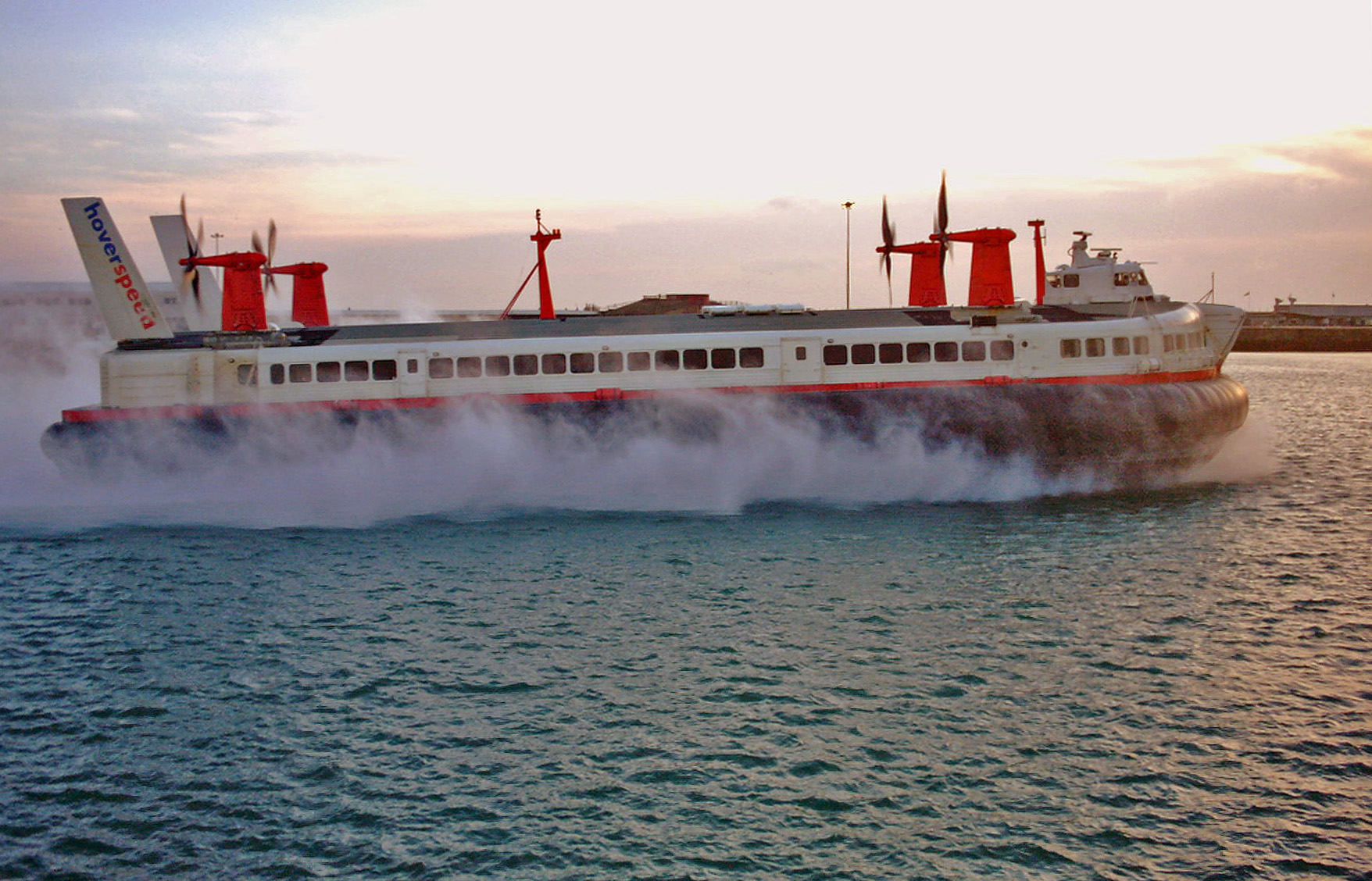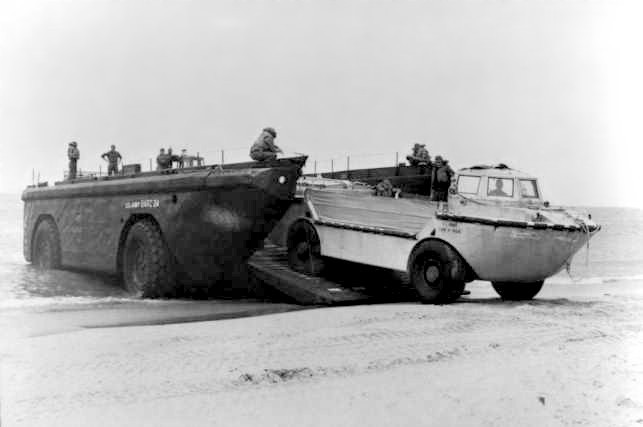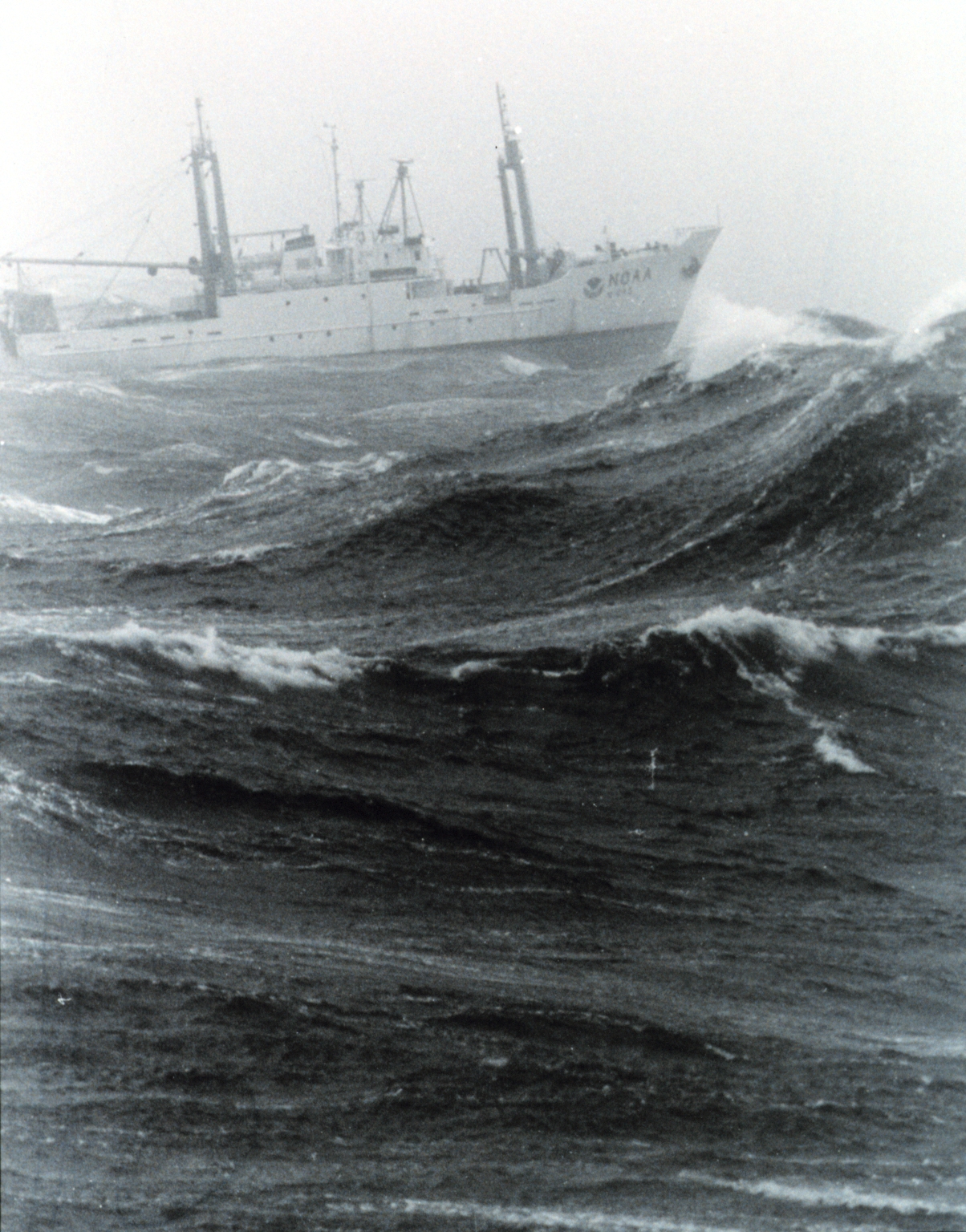|
LACV-30
The LACV-30 (Lighter Air Cushion Vehicle, 30 tons) was a hovercraft used by the U.S. Army Mobility Equipment Research and Development Command (MERADCOM) for offloading cargo from amphibious ships. For logistic transport, the Army was already using the LARC-V and LARC-LX, huge 4-wheeled vehicles referred to as 'barges on wheels'. The Army used the LACV-30 to transport 20 ft. standard MILVAN containers as well as outsize loads that would not fit on a LARC-V or LARC-LX. MERADCOM operated 24 LACV-30s between 1983 and 1994. The LACV-30 was derived from the civilian Bell Voyageur air-cushion vehicle (hovercraft). It is capable of carrying 30 tons (27 tonnes). The hull is that of a large barge, but behind the deck house at the stern, there are 2 air propellers, which are followed by rudders, while under the hull there is a cushion of air which is inflated by 2 fans. There is a large crane at the bow, with a rectangular superstructure shaped like that of a typical river barge. A notewort ... [...More Info...] [...Related Items...] OR: [Wikipedia] [Google] [Baidu] |
Hovercraft
A hovercraft, also known as an air-cushion vehicle or ACV, is an amphibious Craft (vehicle), craft capable of travelling over land, water, mud, ice, and other surfaces. Hovercraft use blowers to produce a large volume of air below the hull, or air cushion, that is slightly above atmospheric pressure. The pressure difference between the higher pressure air below the hull and lower pressure ambient air above it produces lift, which causes the hull to float above the running surface. For stability reasons, the air is typically blown through slots or holes around the outside of a disk- or oval-shaped platform, giving most hovercraft a characteristic rounded-rectangle shape. The first practical design for hovercraft was derived from a British invention in the 1950s. They are now used throughout the world as specialised transports in disaster relief, coastguard, military and survey applications, as well as for sport or passenger service. Very large versions have been used to t ... [...More Info...] [...Related Items...] OR: [Wikipedia] [Google] [Baidu] |
Hovercraft
A hovercraft, also known as an air-cushion vehicle or ACV, is an amphibious Craft (vehicle), craft capable of travelling over land, water, mud, ice, and other surfaces. Hovercraft use blowers to produce a large volume of air below the hull, or air cushion, that is slightly above atmospheric pressure. The pressure difference between the higher pressure air below the hull and lower pressure ambient air above it produces lift, which causes the hull to float above the running surface. For stability reasons, the air is typically blown through slots or holes around the outside of a disk- or oval-shaped platform, giving most hovercraft a characteristic rounded-rectangle shape. The first practical design for hovercraft was derived from a British invention in the 1950s. They are now used throughout the world as specialised transports in disaster relief, coastguard, military and survey applications, as well as for sport or passenger service. Very large versions have been used to t ... [...More Info...] [...Related Items...] OR: [Wikipedia] [Google] [Baidu] |
Bell Aerospace
The Bell Aircraft Corporation was an American aircraft manufacturer, a builder of several types of fighter aircraft for World War II but most famous for the Bell X-1, the first supersonic aircraft, and for the development and production of many important civilian and military helicopters. Bell also developed the Reaction Control System for the Mercury Spacecraft, North American X-15, and Bell Rocket Belt. The company was purchased in 1960 by Textron, and lives on as Bell Textron. History As a pilot, Larry Bell saw his first plane at an air show, starting a lifelong fascination with aviation. Bell dropped out of high school in 1912 to join his brother in the burgeoning aircraft industry at the Glenn L. Martin Company, where by 1914 he had become shop superintendent. By 1920, Bell was vice president and general manager of Martin, then based in Cleveland. Feeling that he deserved part ownership, in late 1924, he presented Martin with an ultimatum. Mr. Martin refused, and Bell quit ... [...More Info...] [...Related Items...] OR: [Wikipedia] [Google] [Baidu] |
Lighter (barge)
A lighter is a type of flat-bottomed barge used to transfer goods and passengers to and from moored ships. Lighters were traditionally unpowered and were moved and steered using long oars called "sweeps" and the motive power of water currents. They were operated by skilled workers called lightermen and were a characteristic sight in London's docks until about the 1960s, when technological changes made this form of lightering largely redundant. Unpowered lighters continue to be moved by powered tugs, however, and lighters may also now themselves be powered. The term is also used in the Lighter Aboard Ship (LASH) system. The name itself is of uncertain origin, but is believed to possibly derive from an old Dutch or German word, ''lichten'' (to lighten or unload). In Dutch, the word ''lichter'' is still used for smaller ships that take over goods from larger ships. Lighters, albeit powered ones, were proposed to be used in 2007 at Port Lincoln and Whyalla in South Australia to load ... [...More Info...] [...Related Items...] OR: [Wikipedia] [Google] [Baidu] |
11th Transportation Battalion (United States)
The 11th Transportation Battalion ("Over the Shore") is a transportation battalion of the United States Army first formed in 1936. The 11th Transportation Battalion is a subordinate unit of the 7th Transportation Brigade. Lineage * Constituted 1 May 1936 in the Regular Army as the 396th Quartermaster Battalion * Activated 1 October 1941 at Fort Hamilton, New York * Converted and redesignated 17 September 1942 as the 396th Port Battalion, Transportation Corps * Battalion broken up 23 March 1944 and its elements reorganized and redesignated as follows: ** Headquarters and Headquarters Detachment as Headquarters and Headquarters Detachment, 396th Port Battalion ** (Companies A, B, C, and D as the 692d, 693d, 694th, and 695th Port Companies, respectively-hereafter separate lineages) * Inactivated 13 March 1946 in France * Redesignated 29 September 1948 as Headquarters and Headquarters Detachment, 11th Transportation Port Battalion * Activated 4 October 1948 at Fort Eustis, Virginia * ... [...More Info...] [...Related Items...] OR: [Wikipedia] [Google] [Baidu] |
LARC-V
LARC-V (Lighter, Amphibious Resupply, Cargo, 5 ton), is an aluminium-hulled amphibious cargo vehicle capable of transporting 5 tons. It was developed in the United States during the 1950s, and is used in a variety of auxiliary roles to this day. In addition to the United States, LARC-Vs have been used by military forces in Australia, Argentina, Portugal, the Philippines, Singapore and Iceland. Approximately 968 were made. About 500 were destroyed, most by scuttling during the American withdrawal from South Vietnam. About 200 have been retained in U.S. military service. Roughly 100 are privately owned and mostly used for tourism. Operational history The LARC-V was fielded in 1963 and were used extensively by the U.S. Army for over the beach supply during the Vietnam War. They supported the logistical and manpower build up at the start of and during the Vietnam war. Two units arrived from Ft. Story, VA. in June 1965. The 344th Transportation Company (Light Amphibious) setup ha ... [...More Info...] [...Related Items...] OR: [Wikipedia] [Google] [Baidu] |
LARC-LX
The LARC-LX (Lighter, Amphibious Resupply, Cargo, 60 ton), originally designated as BARC (Barge, Amphibious Resupply, Cargo) is a welded steel-hulled amphibious cargo vehicle. Description It could carry up to 100 tons of cargo or 200 people, but a more typical load was 60 tons of cargo or 120 people. The vehicle was powered by four GMC diesel engines positioned in the sides of the hull, each of which drove one wheel on land. Pairs of engines were coupled to drive each of the two -diameter propellers, which propelled the vehicle in the water. Its top speed was on land, or afloat. The operator occupied a small cab on the port side at the aft end of the vehicle. The LARC-LX was used to transport wheeled and tracked vehicles, including beach preparation equipment and general cargo, from ship-to-shore or to inland transfer points. It was also capable of transporting shipping containers, which could be landed from the LARC either by crane, straddle carriers, or rolle ... [...More Info...] [...Related Items...] OR: [Wikipedia] [Google] [Baidu] |
DTIC
The Defense Technical Information Center (DTIC, pronounced "Dee-tick") is the repository for research and engineering information for the United States Department of Defense (DoD). DTIC's services are available to DoD personnel, federal government personnel, federal contractors and selected academic institutions. The general public can access unclassified information through its public website. History The DTIC traces its history to the June 1945 formation of the Air Documents Research Center (ADRC), a joint effort of the US Army Air Force, US Navy and Royal Air Force to build a single collection of captured German aeronautical research, based in London. The ADRC was initially tasked with the sorting of the document collection into three broad groups; documents that would assist the war in the Pacific theater, documents of immediate intelligence interest to the United States or British forces and documents of interest for future research. With the ending of the war in 1945, the ... [...More Info...] [...Related Items...] OR: [Wikipedia] [Google] [Baidu] |
Superstructure
A superstructure is an upward extension of an existing structure above a baseline. This term is applied to various kinds of physical structures such as buildings, bridges, or ships. Aboard ships and large boats On water craft, the superstructure consists of the parts of the ship or a boat, including sailboats, fishing boats, passenger ships, and submarines, that project above her main deck. This does not usually include its masts or any armament turrets. Note that in modern times, turrets do not always carry naval artillery, but they can also carry missile launchers and/or antisubmarine warfare weapons. The size of a watercraft's superstructure can have many implications in the performance of ships and boats, since these structures can alter their structural rigidity, their displacements, and/or stability. These can be detrimental to any vessel's performance if they are taken into consideration incorrectly. The height and the weight of superstructure on board a ship or a bo ... [...More Info...] [...Related Items...] OR: [Wikipedia] [Google] [Baidu] |
River Barge
Barge nowadays generally refers to a flat-bottomed boat, flat-bottomed inland waterway vessel which does not have its own means of mechanical propulsion. The first modern barges were pulled by tugs, but nowadays most are pushed by Pusher (boat), pusher boats, or other vessels. The term barge has a rich history, and therefore there are many other types of barges. History of the barge Etymology "Barge" is attested from 1300, from Old French ''barge'', from Vulgar Latin ''barga''. The word originally could refer to any small boat; the modern meaning arose around 1480. ''Bark'' "small ship" is attested from 1420, from Old French ''barque'', from Vulgar Latin ''barca'' (400 AD). The more precise meaning of Barque as "three-masted sailing vessel" arose in the 17th century, and often takes the French spelling for disambiguation. Both are probably derived from the Latin ''barica'', from Greek language, Greek ''baris'' "Egyptian boat", from Coptic language, Coptic ''bari'' "small bo ... [...More Info...] [...Related Items...] OR: [Wikipedia] [Google] [Baidu] |
Sea State
In oceanography, sea state is the general condition of the free surface on a large body of water—with respect to wind waves and swell—at a certain location and moment. A sea state is characterized by statistics, including the wave height, period, and spectrum. The sea state varies with time, as the wind and swell conditions change. The sea state can be assessed either by an experienced observer (like a trained mariner) or by using instruments like weather buoys, wave radar or remote sensing satellites. In the case of buoy measurements, the statistics are determined for a time interval in which the sea state can be considered to be constant. This duration has to be much longer than the individual wave period, but shorter than the period in which the wind and swell conditions can be expected to vary significantly. Typically, records of one hundred to one thousand wave periods are used to determine the wave statistics. The large number of variables involved in creating and des ... [...More Info...] [...Related Items...] OR: [Wikipedia] [Google] [Baidu] |
Naval History & Heritage Command
The Naval History and Heritage Command, formerly the Naval Historical Center, is an Echelon II command responsible for the preservation, analysis, and dissemination of U.S. naval history and heritage located at the historic Washington Navy Yard. The NHHC is composed of 42 facilities in 13 geographic locations including the Navy Department Library, 10 museums and 1 heritage center, USS ''Constitution'' repair facility and detachment, and historic ship ex-USS ''Nautilus''. Command history The Naval History and Heritage Command traces its lineage to 1800, when President John Adams requested Benjamin Stoddert, the first Secretary of the Navy, prepare a catalog of professional books for use in the Secretary's office. When the British invaded Washington in 1814, this collection, containing the finest works on naval history from America and abroad, was rushed to safety outside the Federal City. After that, the library had many locations, including a specially designed space in the S ... [...More Info...] [...Related Items...] OR: [Wikipedia] [Google] [Baidu] |









